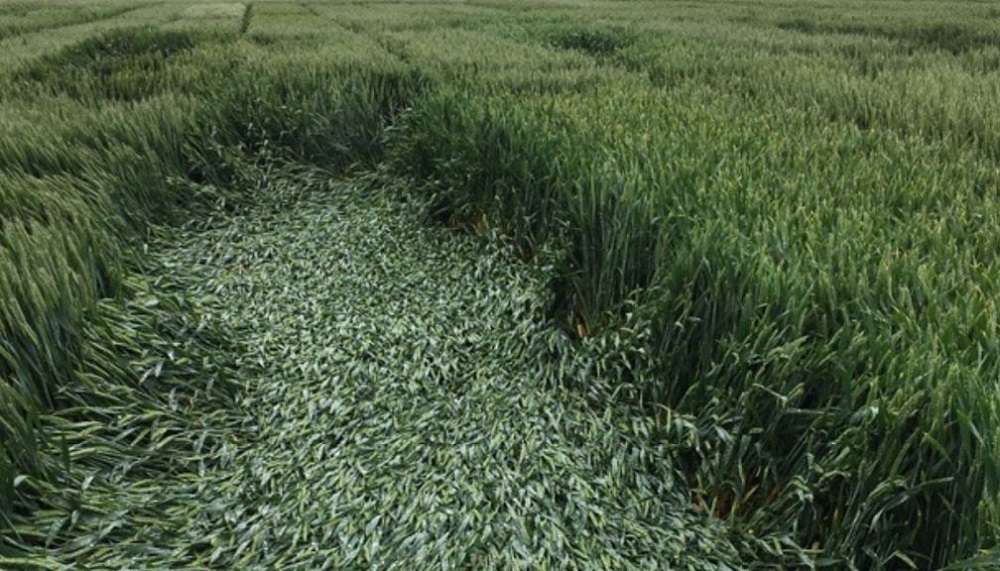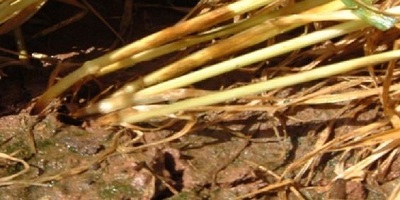- Home
- Knowledge library
- An introduction to lodging in cereals
An introduction to lodging in cereals
In the UK, relatively widespread lodging of cereal crops occurs every few years. With potentially serious effects on yield and quality, it is important to understand and manage the risk to crops. On this page, the three main types of lodging are described.
Use our lodging-risk calculator to identify management options for winter wheat
What is lodging in cereals?
Lodging is defined as the permanent displacement of a stem (or part of a stem) from a vertical posture. It is often caused by high wind speeds, made worse by wet conditions. It can happen quickly (in a day) or relatively slowly, with stems initially leaning. In extreme situations, crops may be forced flat. The earlier that lodging occurs during grain filling, the greater the yield loss.
In tall crops, the aerial parts of the plant impose a relatively large force on the stem base and root system. However, lodging risk is more influenced by weight distribution along the shoot, root anchorage and stem strength.
All components of lodging risk can be altered by choice of variety and husbandry.
The Recommended Lists (RL) provides a lodging resistance rating for each winter wheat and winter barley variety – with and without plant growth regulators (PGR). The RL also includes lodging ratings without PGR for spring barley, winter oats and spring oats. Finally, resistance to brackling is also presented for spring barley. Ratings use a 1–9 score, where 9 indicates a high level of resistance to lodging.
Factors that increase lodging risk in cereals
- Low varietal lodging resistance (see Recommended Lists)
- High soil nitrogen levels
- Fertliser nitrogen applied early or in excessive amounts
- High plant populations
- Large canopies (high GAI)
Note: Plant growth regulators (PGRs) reduce lodging risk, primarily by shortening the crop.
The costs of lodging
Lodging is predicted to affect as much as 20% of the UK winter wheat area every few (three to four) years. Early lodging results in the largest economic losses, due to its greater impact on the grain-filling period. Lodging around ear emergence may result in yield losses of up to 75%. Lodging also adversely affects quality characteristics, such as Hagberg Falling Number and specific weight. Lodged crops often require extra drying.
How to measure lodging
Use a metre ruler to measure the height from the ground to the top of the stem, base of ear or top of ear. Take an average of at least 10 shoots. Before GS39, the main stem (largest stem) of a plant should be measured but, after this, any tiller can be measured. The proportion of a crop that is lodged can be assessed from its first occurrence.
A percentage lodging index can be calculated:
Lodging Index = % Crop leaning (10° to 45° from vertical) ÷ 3 + % Lodging (>45° from vertical but not flat) ÷ 2 + % Lodged flat to ground

Lodging at a wheat variety trial
Components of stem strength
.JPG)
The three types of lodging
There are three main types of lodging: root lodging, stem lodging and brackling.
Root lodging

Root lodging is when the root system has insufficient anchorage to hold up the plant against leverage. It is often made worse by windy and wet conditions. Just 6–11 mm of rain in a day reduces soil surface strength and significantly increases the risk of root lodging. Root systems with greater spread (depth and width) are less prone to root lodging. Soils with good crumb structure, low clay content or high organic matter tend to provide less anchorage, increasing lodging risk. In general, barley is less prone to root lodging, compared to stem lodging/brackling.
- The RL rating system combines root and stem lodging
- A high number on the 1–9 scale indicates high resistance to lodging
- Ratings (with and without PGR) available for several cereal crops
- Specific data on root and stem lodging may be available from breeders
Stem lodging

Stem lodging occurs when the stem base has insufficient strength to hold up the shoot against leverage. It can result in buckling of the stem base. It occurs relatively close to, or below, the ground. Stem strength depends on stem diameter and the composition and width of the stem wall.
- The RL rating system combines root and stem lodging
- A high number on the 1–9 scale indicates high resistance to lodging
- Ratings (with and without PGR) available for several cereal crops
- Specific data on root and stem lodging may be available from breeders
Brackling
 in a barley trial.JPG)
Brackling is the term used when folding/buckling or breaking of the stem occurs relatively high up the plant.
- In RL trials, assessments are carried out on spring barley at harvest
- A high number on the 1–9 scale indicates high resistance to brackling
Topics:
Sectors:
Tags:

